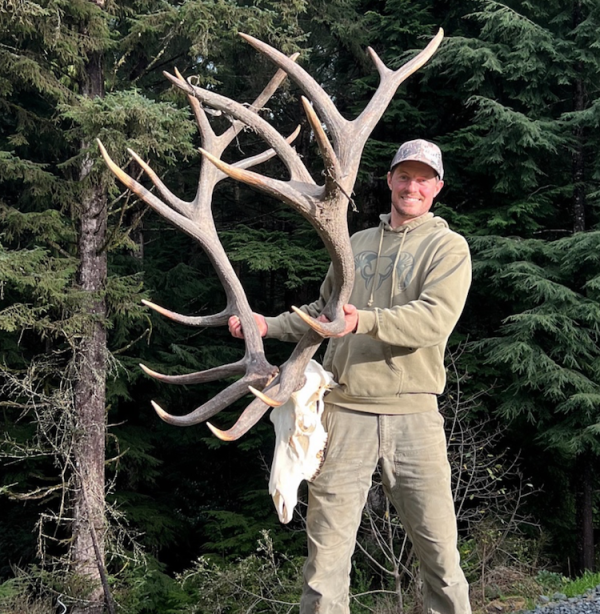B&C Three-Year Findings Give Insight to Trends in Big Game

MISSOULA, Mont. – Record-class specimens of Canada moose, desert sheep, non-typical American elk and Columbia blacktail deer, Roosevelt’s elk and typical Sitka blacktail deer have become more common afield, based on newly compiled records by Boone and Crockett Club.Conversely, records reveal a stable or opposite trend for other categories of native North American big-game species.
The Club recently compiled records for the period 2013-15 in preparation for its triennial tribute to big-game conservation and management – the 29th Big Game Awards, July 14-16, in Springfield, Missouri. The event, hosted by Bass Pro Shops, features a public exhibition of the largest trophies from this three-year period, including two new World’s Record Alaska-Yukon moose and pronghorn and records-book specimens taken by youths. The exhibit is open free to the public May 9 – July 31 at the Bass Pro Shops store. Go to www.biggameawards.com for event details.
“We’re looking at the last three years’ worth of entries in 36 categories of big game, and comparing the data to previous three-year recording periods,” said Richard Hale, chairman of the Club’s Records Committee. “And, we’re finding many reasons to celebrate the current state of conservation, as well as a few causes for concern.”
Within the 2013-15 record book entries, the condition of most categories of big-game species is considered stable, with comparatively insignificant gains or losses compared to preceding recording periods. This list includes Alaska brown bear, Alaska-Yukon moose, bison, black bear, grizzly bear, non-typical Columbia blacktail and Sitka blacktail deer, Rocky Mountain goat, Roosevelt’s elk, Shiras’ moose, Stone’s sheep, typical American elk, typical Coue’s whitetail deer, and typical and non-typical whitetail deer.
Significant uptrends in entries from 2010-12 to 2013-15 include:
Non-typical Columbia blacktail deer, up 42 percent
Typical Sitka blacktail deer, up 40 percent
Desert sheep, up 24 percent
Non-typical American elk, up 24 percent
Non-typical Coues’ whitetail deer, up 18 percent
Canada moose, up 17 percent
Woodland caribou, up 14 percent
Roosevelt’s elk, up 13 percent
Noteworthy downtrends in entries from 2010-12 to 2013-15 include:
Quebec-Labrador caribou, down 92 percent
Central Canada barren ground caribou, down 78 percent
Mountain caribou, down 55 percent
Musk ox, down 42 percent
Typical Columbia blacktail deer, down 37 percent
Pronghorn, down 30 percent
Typical mule deer, down 24 percent
Bighorn sheep, down 22 percent
Non-typical mule deer, down 20 percent
Cougar, down 20 percent
Tule elk, down 19 percent
Dall’s sheep, down 19 percent
Hale said, “Three years ago we were most concerned about our caribou, and still are, but woodland caribou are making a nice rebound. Entries for Quebec-Labrador caribou are still very low, but that is to be expected because hunting for them has been scaled back over the past two years as herds are given time to rebound.”
The decline of the Newfoundland woodland caribou herds has been linked to habitat loss due to too many caribou.
He explained, “Antler and horn size in most species is directly linked to age and habitat quality, which is what makes these data valuable as a yardstick indicating how we are doing managing both game and their habitats. The first sign of recovering habitat is antler quality and right now there are some tremendous woodland bulls coming out of Newfoundland. This follows what we’re seeing on the ground there. Herds exploded then crashed, habitat recovered, and now herds are on the rebound.”
Hunters led the restoration, conservation, and management practices that brought many big-game species from vanishing to flourishing, and Hale expects our wildlife and science experts, with the support of sportsmen and others to do the same for those species needing a helping hand today.
Boone and Crockett Club began keeping trophy records in 1906 as a way of detailing species once thought headed for extinction. Today, trophy data reflect population health and habitat quality. Older animals being taken are a reflection of population balance and a low off take. Biologists compare and contrast records to improve local management strategies, as well as state and federal wildlife policies.
The Club began hosting public exhibitions in 1947 so that citizens could see the big game animals that Boone and Crockett honors as symbols of America’s historic conservation system. That tradition will continue in Springfield, Missouri, July 14-16, with Boone and Crockett Club’s 29th Big Game Awards. The event is designed to celebrate past, present, and ongoing conservation successes–and draw attention to the conservation needs of the future.
To date, the growing list of sponsors for the Boone and Crockett Club 29th Big Game Awards, includes Bass Pro Shops, Wild Sheep Foundation, Federal Premium Ammunition, Dallas Safari Club, DNZ Products, Americase, Weatherby, Leupold & Stevens, the Rocky Mountain Elk Foundation, Kimber Manufacturing, Buck Knives, the Mule Deer Foundation, the Guide and Outfitters Association of British Columbia, Yellowstone Press, and Bear Trust International.
About the Boone and Crockett Club
Founded by Theodore Roosevelt in 1887, the Boone and Crockett Club promotes guardianship and visionary management of big game and associated wildlife in North America. The Club maintains the highest standards of fair-chase sportsmanship and habitat stewardship. Member accomplishments include enlarging and protecting Yellowstone and establishing Glacier and Denali national parks, founding the U.S. Forest Service, National Park Service and National Wildlife Refuge System, fostering the Pittman-Robertson and Lacey Acts, creating the Federal Duck Stamp program, and developing the cornerstones of modern game laws. The Boone and Crockett Club is headquartered in Missoula, Montana. For details, visit www.boone-crockett.org.







